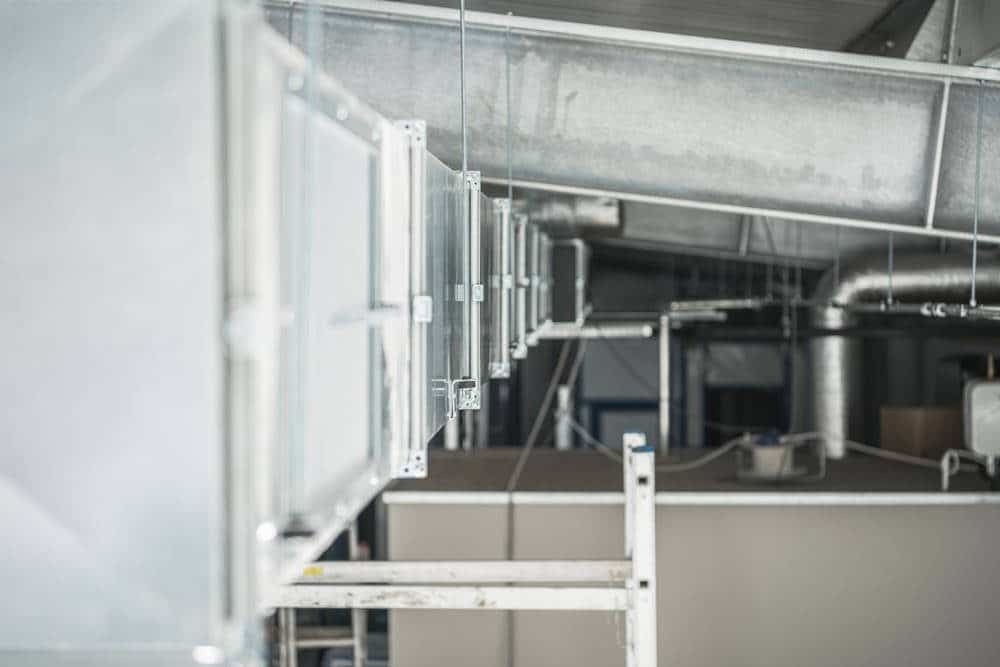
Hospital kitchens are a clear example of such environments due to the cooking fumes emitted during cooking: frying, stewing, and boiling. These can significantly affect the air quality. However, adequate ventilation can be critical in averting the risks of poor air quality.
Let’s explore why.
Why is Adequate Hospital Kitchen Ventilation Important?
Hospital’s heating, ventilation, and air conditioning (HVAC) systems eliminate smoke, steam, grease and other airborne particles that are a by-product of cooking from the air. Efficient kitchen exhaust systems (exhaust fans, ducts, hoods, etc.) can prevent unintentional fire hazards and guarantee a controlled kitchen temperature and air that is safe for breathing.
Failure to implement and maintain adequate kitchen ventilation leads to poor air quality— a safety and health risk for everyone who interacts with the kitchen space and other areas the air filters through. For example, breathing contaminated air from odour, fumes, and other air pollutants leads to many health issues, including lethargy, inflammation, respiratory problems, oxidative stress, and cell mutagenicity, among other health issues.
However, following sustainable kitchen air quality practices can mitigate these risks. The Australian Commission on Safety and Quality in Health Care recommends that an effective indoor ventilation system maintain indoor air temperature and humidity control. Furthermore, it should improve air quality by facilitating the supply and movement of clean air, extracting contaminated air and increasing the dilution efficiency of air.
How to Improve Air Quality in Hospital Kitchens
Hospitals must adhere to strict health regulations and guidelines, thus improving the air quality in their kitchen areas. Actionable steps are required to ensure a secure, safe, and healthy hospital environment. These include:
Evaluating the Ventilation System Design
A flawed ventilation design or improper installation can impact the health of staff, patients and visitors. In contrast, a well-designed ventilation system can facilitate the effective removal of air pollutants and contribute to more control over the circulation and filtration of air, thereby safeguarding the health of everyone in the hospital environment.
Therefore, evaluating the ventilation design is vital to grasping the overall performance of the system and its ability to improve the air quality in hospital kitchens.
Regular Maintenance
Establishing a regular maintenance program for hospital HVAC and kitchen exhaust systems enhances their performance. Moreover, routine maintenance helps detect potential risks before they compromise the air quality beyond containment.
During the maintenance, technicians visually analyse all parts of the systems. For instance, they’ll inspect fans and ductwork to identify performance issues. Are they optimally drawing contaminated air and carrying it outside? Is the ductwork leaking or damaged? This high-level assessment is crucial in understanding the state of the hospital’s kitchen exhaust systems and aids in preventing operational challenges.
Monitoring System for Upgrades
A maintenance program can help identify system upgrade opportunities. However, hospitals are encouraged to perform a risk assessment for the ventilation upgrades by following the risk management principles consistent with the current edition of the Australian Guidelines for the Prevention and Control of Infection in Healthcare.
Hospitals can determine the ventilation system’s appropriateness and efficiency through risk assessment by measuring the air exchange rate, airflow direction within or between spaces, temperature and humidity, among other factors.
Regular Cleaning
Commercial kitchens are held to a high hygiene and safety standard—including hospital kitchens and cafeterias. In addition to providing nutritional food and maintaining high alert when handling food for patients, they must maintain control of the temperature within the food environment.
Moreover, they are expected to maintain hygiene regulations of kitchen equipment according to the Food Safety Standards. Thus, regularly cleaning kitchen exhaust systems is paramount in complying with these guidelines.
Without adequately cleaning the exhaust hood or blast fans, for example, odours and greasy puffs of smoke could infiltrate the hospital cafeteria and other areas, posing a considerable health risk for patients, visitors and staff alike. Regularly deep cleaning these systems is essential to prevent the growth and spread of harmful pathogens. Additionally, efficient exhaust systems operate at a lower cost, reducing energy expenses and extending the equipment’s lifespan, saving money and resources in the long run.
Overall, prioritising the maintenance of exhaust systems is essential for creating a healthier, safer, and more cost-effective environment for everyone in the healthcare facility.
Best Practices for Deep Cleaning Kitchen Ventilation Systems
Hospitals must regularly prioritise cleaning the hospital’s kitchen ventilation system, following the manufacturer’s recommendations for adequate results.
Alternatively, deep cleaning kitchen exhaust systems can be a huge undertaking that often requires professionals’ knowledge, skill and patience. They possess the experience vital in satisfactorily eliminating buildup in exhaust systems by utilising specialised cleansers and degreasers.
Furthermore, they can offer additional cleaning services that enhance the standard and quality of the systems. For example, hand scraping and steam cleaning are highly recommended services. Scraping involves scraping accessible areas of the exhaust system, including the range hood, drip cups, exhaust ducts, and exhaust fans, to prevent grease from build-up that can cause flash fires. Steaming involves using specialised equipment and hot and pressurised water to clean unwanted build-up thoroughly.
Conclusion
Maintaining good air quality in hospital kitchen exhaust systems is crucial. It should be a top priority for all hospitals to comply with the strict Australian standards and regulations set for healthcare facilities.
Following proper maintenance, cleaning, and upgrade protocols, hospitals can ensure a healthy and safe environment for their staff, patients, and visitors. Neglecting this aspect of healthcare facility management can lead to legal and financial repercussions. Therefore, it is essential to adhere to best practices and guidelines to avoid negative consequences.
Lotus Commercial can help you improve the air quality in your hospital kitchen through specialised maintenance and deep cleaning solutions. Contact us today to get started!
